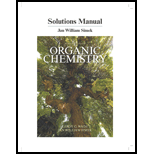
(a)
To determine: The products of the given reaction and the major product if more than one product is formed by the given reaction.
Interpretation: The products of the given reaction and the major product if more than one product is formed by the given reaction are to be predicted.
Concept introduction: The
In acid-catalyzed dehydration, a saturated compound is converted to an unsaturated compound in the presence of an acid catalyst.
(b)
To determine: The products of the given reaction and the major product if more than one product is formed by the given reaction.
Interpretation: The products of the given reaction and the major product if more than one product is formed by the given reaction are to be predicted.
Concept introduction: The chemical reaction that consists of an alkyl halide, a good leaving group that reacts with Lewis base to form an alkene is termed as elimination reaction. In this reaction there is complete removal of the leaving group without any substitution.
In acid-catalyzed dehydration, a saturated compound is converted to an unsaturated compound in the presence of an acid catalyst.
(c)
To determine: The products of the given reaction and the major product if more than one product is formed by the given reaction.
Interpretation: The products of the given reaction and the major product if more than one product is formed by the given reaction are to be predicted.
Concept introduction: The chemical reaction that consists of an alkyl halide, a good leaving group that reacts with Lewis base to form an alkene is termed as elimination reaction. In this reaction there is complete removal of the leaving group without any substitution.
Want to see the full answer?
Check out a sample textbook solution
Chapter 7 Solutions
Student's Solutions Manual for Organic Chemistry
- What is the product of the reaction? F3C. CF3 OMe NaOH / H₂Oarrow_forwardWhat would you expect to be the major product obtained from the following reaction? Please explain what is happening here. Provide a detailed explanation and a drawing showing how the reaction occurs. The correct answer to this question is V.arrow_forwardPlease answer the question for the reactions, thank youarrow_forward
- What is the product of the following reaction? Please include a detailed explanation of what is happening in this question. Include a drawing showing how the reagent is reacting with the catalyst to produce the correct product. The correct answer is IV.arrow_forwardPlease complete the reactions, thank youarrow_forwardConsider the synthesis. What is compound Y? Please explain what is happening in this question. Provide a detailed explanation and a drawing to show how the compound Y creates the product. The correct answer is D.arrow_forward
- What would be the major product of the following reaction? Please include a detailed explanation of what is happening in this question. Include steps and a drawing to show this reaction proceeds and how the final product is formed. The correct answer is B. I put answer D and I don't really understand what is going on in the question.arrow_forwardWhat is the product of the following reaction? Please explain what is happening in this question. Provide a detailed explanation and a drawing showing how the reagent is reacting with the catalysts to product the correct product. The correct answer is B.arrow_forwardWhat is the missing intermediate 1 and the final product 2. Please include a detailed explanation explaining the steps of malonic ester synthesis. Please include drawings of the intermediate and how it occurs and how the final product is former.arrow_forward
 Organic Chemistry: A Guided InquiryChemistryISBN:9780618974122Author:Andrei StraumanisPublisher:Cengage Learning
Organic Chemistry: A Guided InquiryChemistryISBN:9780618974122Author:Andrei StraumanisPublisher:Cengage Learning
